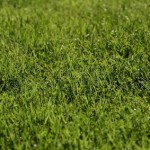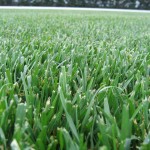Written by Ben Edington
With extreme heat and drought pushing the physiological limits of most lawns in Indiana, not only have most lawns gone dormant, but many homeowners will find that their lawns will not recover from this severe weather. Most lawns can maintain summer dormancy for 5-8 weeks. After that point, plants begin to die and one must think about what to do next.  If you have spent this summer and the last few summers moving around sprinklers, constantly adjusting irrigation systems, and then being afflicted with a watering ban, perhaps it is time to change your approach. While no one wants to see their lush lawn crash and burn, a year like this gives one the opportunity to start over with a clean slate and evaluate many of the drought tolerant lawns and the varieties of turfgrass that have been tested under the most extreme conditions. By starting over with a drought tolerant turfgrass variety, you can relax and have the greenest lawn on the block while conserving water and alleviating much of the headache.
If you have spent this summer and the last few summers moving around sprinklers, constantly adjusting irrigation systems, and then being afflicted with a watering ban, perhaps it is time to change your approach. While no one wants to see their lush lawn crash and burn, a year like this gives one the opportunity to start over with a clean slate and evaluate many of the drought tolerant lawns and the varieties of turfgrass that have been tested under the most extreme conditions. By starting over with a drought tolerant turfgrass variety, you can relax and have the greenest lawn on the block while conserving water and alleviating much of the headache.
Knowing that most lawns will need special attention in the coming months, now is the time to begin thinking about the next step. August 15th to September 15th is the ideal time to reseed a lawn. This is due to the return of adequate soil moisture, warm soil temperature, and limited competition from weeds. With careful research into the best varieties available you can begin the transition to a worry free lawn. This is not a time to cut corners or pinch pennies. Spending a little extra money on quality grass seed, and employing a trustworthy company to perform the work, will save countless hours in time and money.
Tall Fescue
The new turf type tall fescue varieties of grass are an excellent choice for starting a new lawn. With a probing root system that can reach 2 to 4 feet, fescue has excellent drought tolerance. It requires half the amount of fertilizer as Kentucky bluegrass to look green and lush. Most tall fescues contain naturally occurring endophytes that naturally control grubs. Even if no endophytes are present, tall fescue can sustain higher levels of grub populations before damage is shown compared to Kentucky bluegrass. Tall fescue germinates quickly in 7 to 14 days. One setback is that it grows in clumps and will not fill in bare spots like Kentucky bluegrass will. Increased drought tolerance in tall fescue varieties makes it an exceptional option for home lawns.
Kentucky Bluegrass
For decades Kentucky bluegrass was the standby for lawns in Indiana. As a high quality lawn it is almost unrivaled. However, Kentucky bluegrass does have a few setbacks. It is relatively shallow rooted, so it requires a lot of water. In summer, it is common for this species to go into summer dormancy, although it can survive in this state for quite some time. Also, it requires quite a bit of fertilizer to keep it lush and green. It is commonly afflicted by grub damage. Germination usually takes from 21 to 28 days, so one must be patient getting it established. Some of the benefits are that it actively fills in bare spots by spreading rhizomes and it stands up to trafficked areas. Breeding for drought tolerant varieties has alleviated some of the watering issues.
Getting Started
Lawns can either be sprayed with a non-selective herbicide to completely kill all existing vegetation or they can be overseeded with the desired seed. Lawns should be core aerated to reduce compaction and improve seed to soil contact. The next step is to use a specialized machine called a slice seeder that cuts a series of grooves into the soil and deposits the seed into the grooves. This ensures proper seed to soil contact. The machine should be used in two perpendicular directions to achieve proper coverage. A special seed starter fertilizer should be used at the time of seeding to provide necessary nutrients for seeds to grow and establish.
Core Aeration
If your lawn has been fortunate enough to make it through the summer unscathed, you should still consider core aeration. As a cultural practice, it is one of the most beneficial processes you can do for your lawn. Core aeration reduces compaction as well as the thatch layer. This allows better movement of water and air into the root system. A reduced thatch layer minimizes an environment that harbors insect and disease, and, allows turf products to work more effectively. The process of core aeration also stimulates grass plants to produce more roots and shoots, making them better able to withstand future drought.
Unfortunately, the drought of 2012 has wreaked havoc on many lawns and watering restrictions have exacerbated the problem. However, it will give many homeowners an opportunity to reevaluate their lawns and create an opportunity to start over with a high quality lawn while reducing water needs at the same time. If done with the right varieties and attention to details, an initial investment can save money in water bills and upkeep in the future. If you need help evaluating your lawn for drought damage, or transitioning to a drought tolerant lawn, contact the knowledgeable staff at Mark M. Holeman for guidance.


